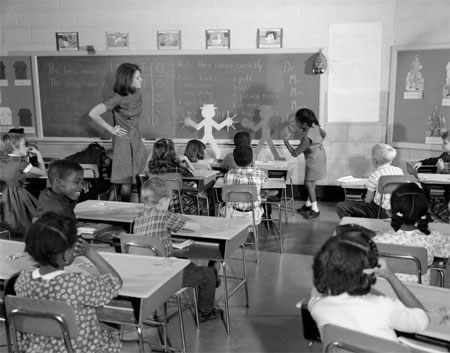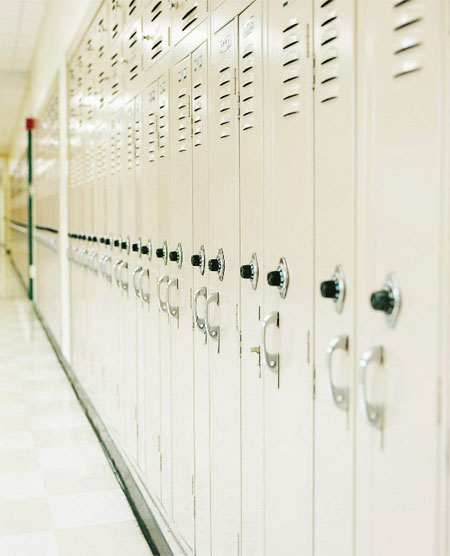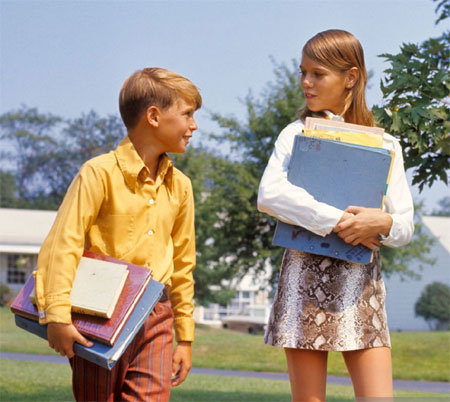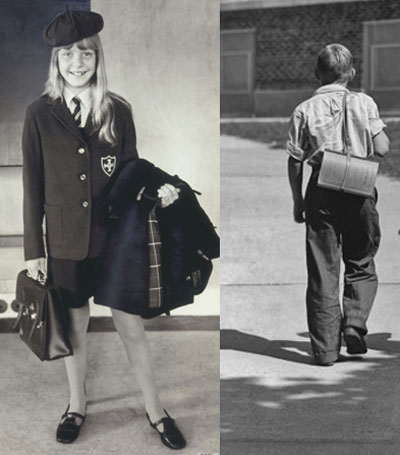Carrying Schoolbooks
It may seem a little thing, but the carrying of books—and the way you carried them—was a big part of high school when I was a teenager.
In grade school, which is what we called Kindergarten through 6th grade (roughly ages 5 to 11), because we always sat in the same seat in the same classroom all day, we left our books in our desks. All that changed when we entered high school (or, more properly, junior high, which was grades 7 and 8, but which occupied the same building as the high school kids, in grades 9 through 12).

And notice the picture itself—it cost me ten quid!
I still remember going on an introductory tour of the Ichabod Crane High School, which was just outside the village of Valatie, a mile or so from Martin H Glynn, the grade school I was attending. Compared to the Glynn school, it was immense, and the hallways were lined with lockers. As I recall, they seemed impossibly tall, but then I was still only 4’4” tall, so they would look big to me.

At the beginning of the school year, we would be assigned a locker, and given the combination. There was a method of “setting” the lockers, so you didn’t have to put the combination in every time, which involved putting a piece of folded paper under the bar that the handled lifted up, thereby keeping it from returning to its default position and locking the locker (it sounds complicated, but it was dead easy). This practice was strenuously discouraged by the teachers, but most of us did it anyway.
I write all this because I don’t know if lockers, as I knew them, still exist in American schools (although they remain a staple in every High School drama/movie/sitcom so, if not a thing, they at least seem to have remained in the US Psyche), and they were peripherally responsible for how many books we needed to carry. Our schedules allowed us about 5 minutes to get from one class to the other, which often left little time to visit your locker, so most of us just carried all the books required for our morning classes until lunch, then swapped them for the books we needed for our afternoon classes.
How those books were carried is (mostly) what this is all about: boys carried their books under their arm, Girls carried their books cradled against their chest. I was never told this; it seems to have developed naturally. Why, I cannot say, but it was a convention you did not break, like putting your hands on your hips with your thumbs pointing forward instead of backward.

If this boy was trying to put the make on the girl,
he would be carrying her books for her.
I do know that carrying my books under my arm made it easier for the jocks to knock them out of my hands and kick them down the hall before locking me in a locker, which isn’t as bad as it sounds. This was how things worked: some kids picked on other kids; some kids were picked on by other kids. This, too, was a convention, and it was best to not fight against it.
Which was why when one kid decided to carry his books in a backpack, things did not go well for him.
I knew the kid (this was during my Jesus Freak years, and he was part of the group I was in), and he was the sort of kid who, even if he wasn’t a Jesus Freak and didn’t wear a backpack to school, would still have been a bully magnet. When he first showed up wearing it, I thought it was a brilliant idea, but the resulting harassment he endured did not encourage me—or anyone else—to copy him. I graduated shortly after that and the issue of how, or in what, I carried my books suddenly disappeared.
I didn’t think about it again until years later, when my own kids went to school, and I learned that students were now carrying their books in book bags (backpacks, or satchels). I remember thinking, “Finally!” and wondering how many other unfortunates had to suffer teasing and abuse before the erstwhile, unconventional oddity had become mainstream.

My wife assures me that, when and where she went to school (Hazelwick, Crawley in the 1970s and 80s), none of this was an issue because they didn’t have lockers and carried all their books, as well as their packed lunch and PE Kit, in a satchel. This convention not only allowed them to have all their work handy to them at all times, it also—one must assume—built up their stamina, and allowed their mums to wash their PE Kit occasionally, which was not always the case in the US (where kids could just bung it in their locker and leave it there until the HazMat Team had to be called in).

These days, it seems, everyone—man, woman, youngsters, pet dogs—wears a backpack (UK: Rucksack) or carries a satchel (it is not a manbag, it’s a satchel!) everywhere they go, and that has made life a lot easier for everyone.
And it keeps the bullies from kicking my books out of my hand.